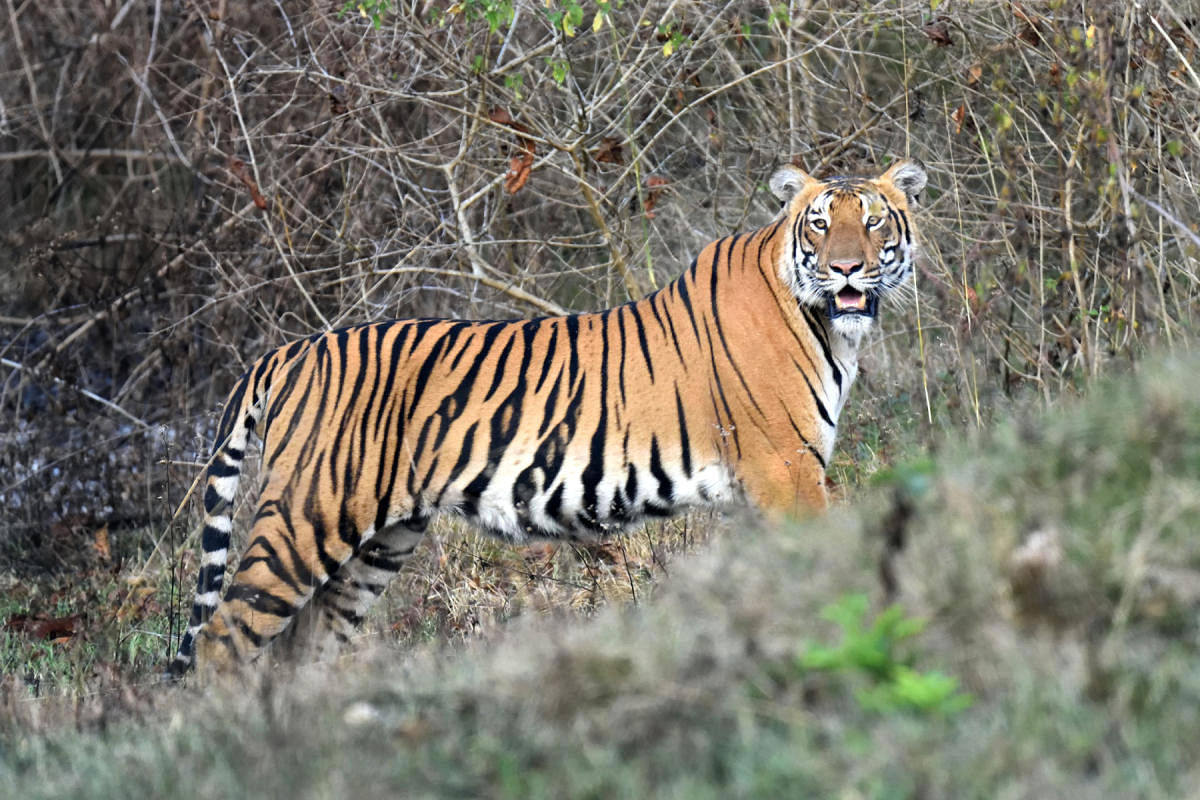Returning to the tiger lands



In the early 1980s, we were just out of college. We had uncontained curiosity and a near-fatal attraction to nature. The Mysuru-Ooty highway, which goes through Bandipur, was itself an amazing jungle safari at that time. A vehicle or two that would pass by once every twenty minutes hardly disturbed the serenity of the forest.
During these wonderful times, we visited Bandipur often, and soon got hooked. Most officers would even encourage these visits once they were convinced that our interest was genuine. We were allowed to go even in our Ambassador car! Being young and enthusiastic, we desperately wanted to spot a tiger in the wild.
The tigers, however, were simply invisible. Eventually, our quest led us to befriend the Jenu Kuruba tribe. We thought our friends, who were more familiar with the forest, would help us spot a tiger on foot. This opened up a whole new world.
We soon realised that thousands of cattle and grazers ruled the forest during the day. Thousands of people carried firewood to their villages, just like ants carrying their eggs in a line, hurrying in the anticipation of rain. The badly understaffed forest department struggled to stop these activities.
Witnessing all this, we wondered whether there was any space left for the tiger and if we would ever be able to see a tiger in the wild.
The first sight
One late evening, as we were walking on a soft dusty cattle track, we came across a big fresh footprint — the pugmark of a tiger! We were ecstatic. Maybe the tiger had followed cattle, or maybe the predator operated late in the evening and at night. We lost ourselves to wild speculation.
Our next move was obvious — we sought permission to sit in a watch tower on moonlit nights. Many nights went by and the calls of the night were strange. Even though we did not see a tiger, those experiences were worth every minute.
‘How does one spot a tiger?’ we asked an officer.
A top secret was revealed — even the Bandipur director had not seen a tiger in the wild in the three years he had been there!
At the time, this was common. Tigers were present, but they would not show up easily. The national park was just about recovering from the days of hunting and poaching. The mothers still taught their cubs to avoid being seen by humans, generation after generation.
Ten years later, in 1995, when we returned to Bandipur to study and film wild dogs, we were more experienced and our understanding of natural history was better.
One afternoon, tiger tracks led us to one of the ponds in the tourism zone. A tiger was sitting with its backside in the water, facing away from us. The wind was favourable and we situated ourselves behind a bush for the next one-and-a-half hours. The tiger barely took notice of us.
Then it got up slowly, stretched itself and left. Four minutes later we heard distant voices, and two minutes later the sound of a vehicle. In another four minutes, a safari bus arrived. The tiger had sensed the arriving humans at least ten minutes in advance.
When we explained to the Deputy Conservator of Forests how these tigers were behaving, he told us something in a low voice, “Somehow show me a tiger too. I am retiring in a few months. My friends laugh at me if I tell them the truth.”
It was not difficult, the tiger returned to the pond the next day, maybe it had a kill nearby.
Current times
Today, the picture of Bandipur has completely changed. Tiger numbers have reached near saturation. They do not shy away from tourist vehicles anymore.
This transformation did not happen overnight. Protection increased, the number of cattle entering the forest reduced and professional poaching, poisoning and timber smuggling dramatically came down. The ‘Namma Sangha’ society has spread its cooking gas distribution network to all the villages along the Bandipur border in the last twenty years, covering over 40,000 families, and thereby weaning people away from entering the forest for firewood.
Years of relentless effort from many dedicated officers have started showing results.
This does not mean that Bandipur is devoid of problems today. As the human population and land prices continue to shoot up, government lands around Bandipur forest are coming under immense pressure.
The buffer of the scrub jungle around the national park, which cushioned conflict, is shrinking at an alarming pace. Invasive plants such as Lantana camara and Senna spectabilis are spreading across the forest, directly affecting endemic plant composition and threatening the very foundation of the ecosystem.
Just the number of tigers going up means little in the long run as genetic diversity is important for long-term conservation.
Even these small pockets of protected forest are further being fragmented by roads and railways.
All that needs to change is the mindset of policymakers. Express highways, fast trains, massive dams, mines or skyscrapers alone do not determine the progress of the country. Undisturbed landscapes are the true expressions of the rich culture and character of a society.
It is time that the definition of development and the path to achieving it are critically redefined and restructured. Only then can our forests and the tens of thousands of lives that depend on them, including humans, survive in harmony.
(Translated from Kannada by Jagadish Angadi)
Deccan Herald is on WhatsApp Channels| Join now for Breaking News & Editor's Picks